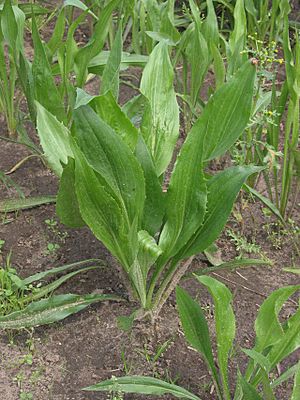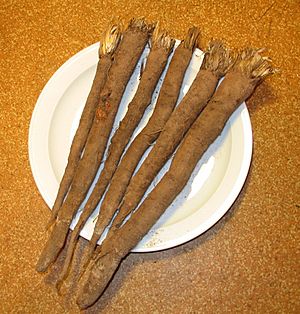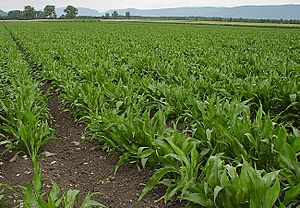Scorzonera hispanica facts for kids
Quick facts for kids Scorzonera hispanica |
|
|---|---|
 |
|
| Scientific classification |
Scorzonera hispanica, often called black salsify or Spanish salsify, is a plant known for its tasty root. People also call it black oyster plant, serpent root, or viper's grass. It's a perennial plant, meaning it lives for more than two years. Black salsify belongs to the same plant family as sunflowers, called Asteraceae. It's grown for its root, much like purple salsify. This plant naturally grows in Southern Europe and is farmed in Southern and Central Europe. It likes to grow in dry areas, rocky places, or in soils with lime.
Contents
What is Black Salsify?
Even though black salsify is a biennial plant (living for two years), farmers usually grow it as an annual, meaning they harvest it in its first year. In its second year, the plant can grow up to 60 cm (about 2 feet) tall. Its flowers are yellow and attract insects for pollination. The stem is smooth, and its leaves are long and narrow.
The most important part is the long, carrot-like root. It has a brownish-black outer layer. When harvested young, the roots are tender and have white flesh inside. Be careful, though! The root contains a milky liquid called latex. This liquid turns black when it touches the air.
A Look Back: History of Black Salsify
Black salsify comes from Southern Europe and the Near East. Many people think it spread from Spain, which is why it's sometimes called "Spanish salsify." However, the first time a Western writer mentioned it was in 1575. He saw it in a market in Aleppo, Syria.
The name Scorzonera might come from an old French word, scorzon, meaning "snake." This makes sense because people once believed the plant could help against snake bites. Another idea is that the name comes from Italian, "scorza negra," which means "black bark" or "black peel," referring to the root's dark skin.
Ancient Celtic and Germanic people likely ate black salsify. Up until the 16th century, they thought it could protect against the bubonic plague and snake bites. By 1660, it was being grown as a vegetable in Italy and France. Soon after, large fields of it appeared in what is now Belgium.
Healthy Benefits of Black Salsify
Black salsify is a very nutritious vegetable. It contains important things like proteins and fats. It also has many minerals, such as potassium, calcium, phosphorus, iron, and sodium. Plus, it's a good source of vitamins A, B1, E, and C.
One special thing about black salsify is that it contains a substance called inulin. Inulin gives the root a mild sweetness. This makes it a good food choice for people with diabetes. Inulin also acts as a dietary fiber, which can help your digestive system work well. It might also be good for your blood circulation and kidneys.
How to Prepare Black Salsify
You can eat different parts of the black salsify plant. The roots, leafy shoots, and even the open flowers can be eaten, either cooked or raw. But the main part people eat is the long root.
The thick black skin of the root is usually not eaten. You can remove it before or after boiling. If you peel it before boiling, put the peeled root into water mixed with vinegar or lemon juice right away. This stops it from turning black. The root has a very sticky milky liquid, so it's often easier to peel it after boiling it for 20 to 25 minutes. If any sticky liquid is left, you can rub it off with a drop of oil and then wash it with soap.
Black salsify is often eaten with other vegetables like peas and carrots. It's also popular served like asparagus, with a white sauce such as bechamel sauce, mustard sauce, or hollandaise sauce. You can also coat boiled salsify roots in batter and deep fry them.
Young roots can be used in salads. The milky liquid from salsify can even be used as chewing gum. The flowering shoots are eaten like asparagus, and the flowers can be added to salads.
In Évora, Portugal, there's a special sweet treat called "scorzonera sweet." It's a crystallized dessert made from scorzonera.
Growing Black Salsify
Black salsify is mostly grown in Europe. Belgium, France, and the Netherlands are the biggest producers. Germany also grows a lot. In Germany, a type called 'Hoffmanns Schwarzer Pfahl' is popular for big farms. 'Duplex' is liked by smaller gardeners. There are other types available too.
Different Types of Black Salsify
Different types of black salsify, called cultivars, have different tastes, sizes, and harvest times. Here are some common ones:
| Cultivar | Attributes |
|---|---|
| Hoffmanns Schwarzer Pfahl |
|
| Duplex |
|
| Einjährige Riesen |
|
Farmers want to grow types that don't flower too early, have fewer holes in the roots, and are easier to plant and harvest with machines.
Planting Seeds
Black salsify seeds are planted in early spring, usually in late April. If planted too early, the plants might flower too soon, which means fewer roots. About 12 kg of seeds are needed for one hectare (about 2.5 acres). The seeds are planted directly into shallow rows, about 1.5 to 2 cm deep. The rows should be 30-50 cm apart. For the best harvest, there should be about 50 plants per square meter.
Planting the seeds with a machine can be tricky because of their unusual shape. Storing the seeds is also important, as they usually only sprout well for 1-2 years. They should be stored in a dry, cool place.
Soil Needs
The roots grow best in very light, sandy soil. If there are any stones or gravel in the ground, the roots can grow into strange shapes. The best soil pH is between 5.8 and 6.5. If the soil is too acidic, adding lime can help. Soil with a lot of humus (rich, dark soil) is also good. Black salsify can grow in many different conditions. This means it could be a good crop for less ideal farming areas in temperate climates.
Harvesting and Storing
You can harvest black salsify from November to March. The best time for good quality roots is usually late December. Harvesting can be a bit tricky because the roots are fragile. If they break, they lose their freshness quickly.
Whole roots can stay fresh all winter if stored in a cool, dark place. Their tough black outer skin helps protect them. In a root cellar, they can stay fresh well into spring. You can also wash, peel, cut, and then freeze the roots. In stores, you might find them in glass jars or cans. At farmer's markets, the roots are often sold unwashed to keep them fresh.
Black salsify is very strong and can handle frost. It grows well in most cool temperate climates. Farmers can usually get 15–20 tonnes of roots per hectare. In home gardens, people often leave the plant in the ground for two years until the roots are big enough to harvest. For commercial farms, it's often grown as a second crop in the year. It's a good idea to wait three to four years before planting other sunflower family plants in the same spot again.
Pests and Diseases
Pests that Affect Black Salsify
- Carrot rust fly (Psila rosae): The larvae of this fly eat the roots and dig into them. This stops the plant from growing well and can lead to infections from bacteria that cause rot.
- Wireworms (Selatosomus destructor and Ctenicera pruinina): These are the larvae of click beetles. They live in the soil for 2-5 years and eat roots. They cause a lot of damage by boring into the roots. This can let in other plant diseases, leading to root rot. Root rot can make seedlings wilt, stop growing, or die.
- Root knot nematode (Meloidogyne incognita, M. javanica, M. hapla, and M. arenaria): These tiny worms can greatly harm salsify roots. They damage the growing tips of the roots, causing them to branch, twist, or become small and deformed. Above ground, the plant might stop growing, wilt, or its leaves might turn yellow.
Diseases that Affect Black Salsify
- Bacterial soft rot (Bacillus carotovorus Jones): This bacteria eats the inside of the root. You can tell it's happening if the root becomes soft, watery, and slimy. This can also make it easier for fungi or other bacteria to infect the plant. This rot likes warm temperatures (21°C - 27°C) but can still cause damage in cooler or hotter conditions. So, it's important to have good air flow when storing and moving the crop in warm places.
- White blister (Albugo species): This is a leaf disease that likes wet weather. It's related to downy mildew, and both can happen at the same time. White blisters look like white bumps on the underside of the leaves. The areas around them might turn purple. This slows down plant growth, and heavily infected parts can shrivel up or even die.
See also
 In Spanish: Escorzonera para niños
In Spanish: Escorzonera para niños



